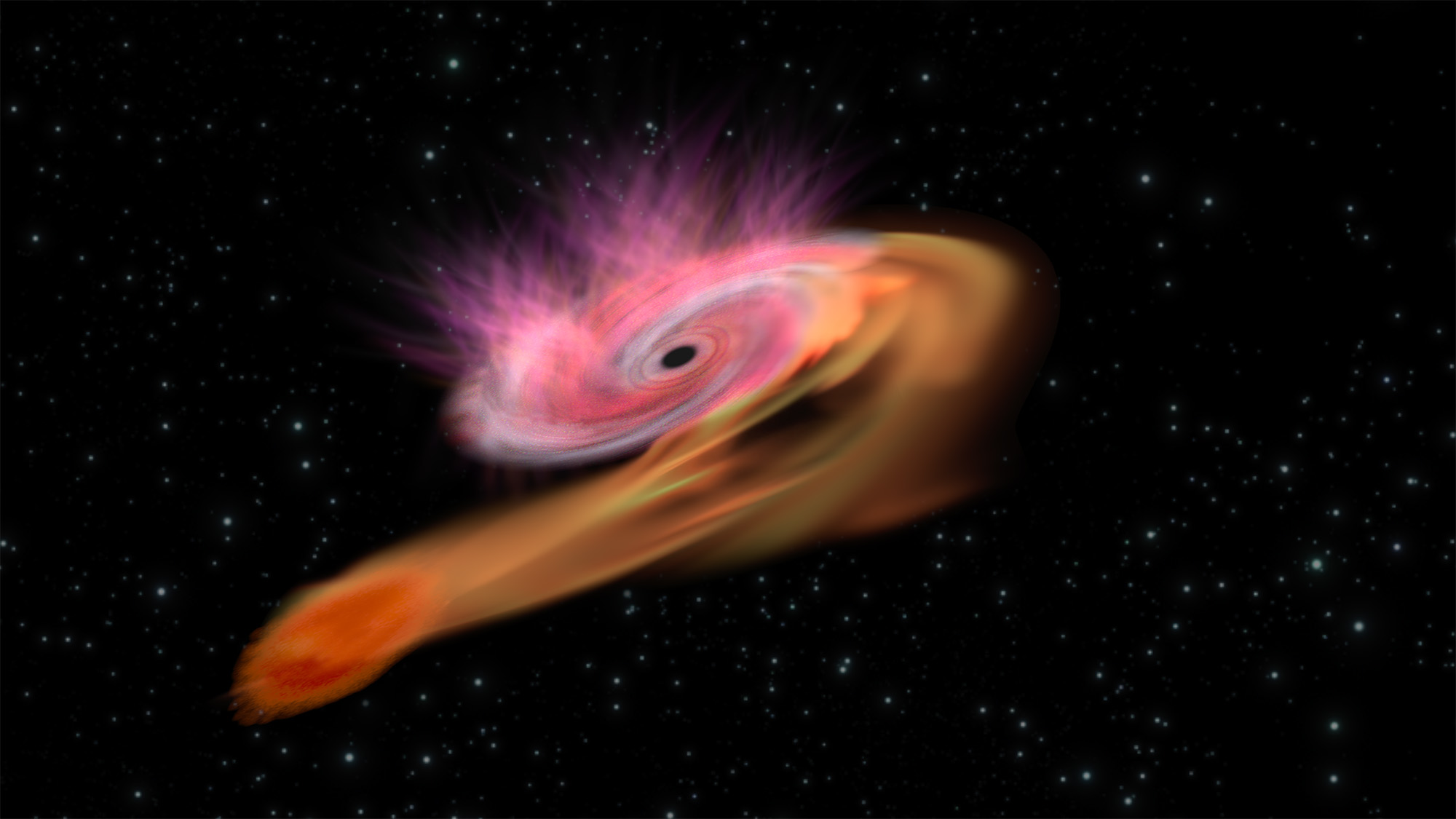2025-05-08 カリフォルニア大学バークレー校(UCB)

Artist’s impression of a massive black hole, located in the dark oval at the center of the swirling cloud, accreting mass from a star (orange) that ventured too close. The star feels a gravitational tug from the black hole that is stronger on one side than on the other, which eventually rips the star apart. In the process, stellar material starts flowing onto the black hole, part of which is captured and the rest ejected, producing a sudden boost in luminosity, especially in X-rays.
ESA/C. Carreau
<関連情報>
- https://news.berkeley.edu/2025/05/08/not-one-but-two-massive-black-holes-are-eating-away-at-this-galaxy/
- https://arxiv.org/abs/2502.17661
オフセット潮汐崩壊現象AT2024tvdによって明らかになったホスト核から0.8 kpc離れた大質量ブラックホール A Massive Black Hole 0.8 kpc from the Host Nucleus Revealed by the Offset Tidal Disruption Event AT2024tvd
Yuhan Yao, Ryan Chornock, Charlotte Ward, Erica Hammerstein, Itai Sfaradi, Raffaella Margutti, Luke Zoltan Kelley, Wenbin Lu, Chang Liu, Jacob Wise, Jesper Sollerman, Kate D. Alexander, Eric C. Bellm, Andrew J. Drake, Christoffer Fremling, Marat Gilfanov, Matthew J. Graham, Steven L. Groom, K. R. Hinds, S. R. Kulkarni, Adam A. Miller, James C. A. Miller-Jones, Matt Nicholl, Daniel A. Perley, Josiah Purdum, Vikram Ravi, R. Michael Rich, Nabeel Rehemtulla, Reed Riddle, Roger Smith, Robert Stein, Rashid Sunyaev, Sjoert van Velzen, Avery Wold
arXive last revised 30 Apr 2025 (this version, v2)
DOI:https://doi.org/10.48550/arXiv.2502.17661
Abstract
Tidal disruption events (TDEs) that are spatially offset from the nuclei of their host galaxies offer a new probe of massive black hole (MBH) wanderers, binaries, triples, and recoiling MBHs. Here we present AT2024tvd, the first off-nuclear TDE identified through optical sky surveys. High-resolution imaging with the Hubble Space Telescope shows that AT2024tvd is 0.914 ± 0.010′′ offset from the apparent center of its host galaxy, corresponding to a projected distance of 0.808 ± 0.009 kpc at z = 0.045. Chandra and VLA observations support the same conclusion for the TDE’s X-ray and radio emission. AT2024tvd exhibits typical properties of nuclear TDEs, including a persistent hot UV/optical component that peaks at Lbb ∼ 6×1043 erg s−1 , broad hydrogen lines in its optical spectra, and delayed brightening of luminous (LX,peak ∼ 3 × 1043 erg s−1 ), highly variable soft X-ray emission. The MBH mass of AT2024tvd is 106±1 M⊙, at least 10 times lower than its host galaxy’s central black hole mass (≳ 108 M⊙). The MBH in AT2024tvd has two possible origins: a wandering MBH from the lower-mass galaxy in a minor merger during the dynamical friction phase or a recoiling MBH ejected by triple interactions. Combining AT2024tvd with two previously known off-nuclear TDEs discovered in X-rays (3XMM J2150 and EP240222a), which likely involve intermediate-mass black holes in satellite galaxies, we find that the parent galaxies of all three events are very massive (∼ 1010.9 M⊙). This result aligns with expectations from cosmological simulations that the number of offset MBHs scales linearly with the host halo mass.



